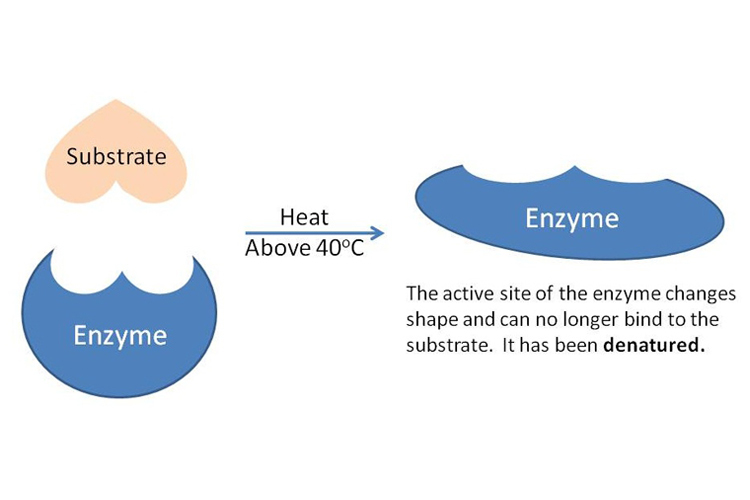Previously on one of our posts, we have learned how proteins can be denatured or activated. Enzymes have similar functions, since they all enzymes are proteins. When temperature, pH, substrate concentration, and enzyme concentration are not within optimal limits, amino acids break and cause changes to the active site of an enzyme.
Temperature
When temperature is below optimum level, molecules move slowly so there is a lesser chance of collision between substrate and active site. On the contrary, as temperature rises, molecules move rapidly and they collide with each other at a greater chance. Eventually at a higher temperature, the enzyme can be denatured and the rate of enzymatic reaction decreases. At the optimal temperature, the rate of enzyme reaction is the greatest. The optimal temperature is different for every organism; for humans it is 37˚C, but for the bacterium Thermus thermophilus it is 65˚C.

pH
Each enzyme has an optimum pH where its enzymatic reaction rate is the greatest. For enzymes in the stomach like pepsin, it is pH 2, but those in the small intestine like trypsin, it is pH 7.5. If pH is lower or higher than the optimum level, the rate of reaction decreases. Specifically in extreme pH values, denaturation occurs.

Substrate Concentration
As substrate concentration decreases, more enzyme molecules are available than substrate. Thus the rate of reaction is low. Yet when substrate concentration is increased, there is a higher chance of collision. The rate of reaction rises until all active sites are utilized by substrate molecules. After this point, addition of substrate molecules will not impact the rate of enzymatic reaction.
In your biology class, you may be given a task in which you must investigate factors affecting enzyme activity. If you are to design a lab, you want to choose the right enzyme and substrate combination, as well as the appropriate independent variables (IV) and dependent variables (DV) so that you can tell how enzyme activity was influenced. Below is a table of enzyme, substrate, and their products that you can use in your experiments. Remember, the IVs in these experiments are the four factors listed above: temperature, pH, substrate concentration, and enzyme concentration.
| Enzyme | Substrate | Product |
| Catalase | Hydrogen Peroxide | Oxygen |
| Lipase | Lipids | Fatty acids |
| Pepsin | Protein | Amino acids Short peptides |
| Amylase | Starch | Maltose |
Denaturation
As mentioned earlier, denaturation can occur in extreme conditions of temperature, pH or enzyme / substrate concentration. It is an irreversible change that causes proteins to no longer function. However, if there is only a slight change in the conditions, denaturation can possibly be reversible. Denaturation harms the tertiary or quaternary structure of a protein, but sometimes the secondary conformation can also be changed.

Works Cited
“Denatured Enzyme.” Science Learning Hub, http://www.sciencelearn.org.nz/images/2264-denatured-enzyme.
“How Does Temperature Affect Enzyme Activity?: PH & Enzymes.” Hygrozyme, 26 Feb. 2018, http://www.hygrozyme.com/resources/temperature-enzyme-activity/.
Leave a comment